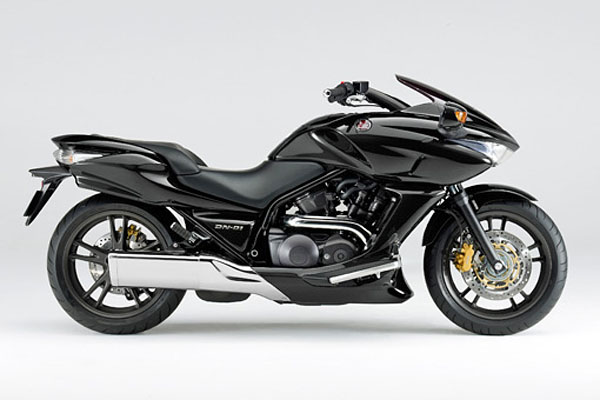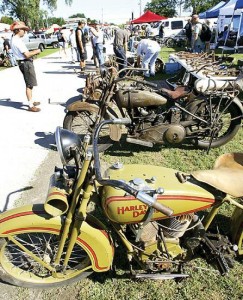Choosing which handlebars you install on your bike can be challenging but fun. Handlebars affect your comfort and the look and handling of your bike, and understanding each type of handlebar will help you make an informed decision you’ll be happy with.
 Image to the left of Ape Hangers taken from Hill Country Customs.
Image to the left of Ape Hangers taken from Hill Country Customs.
Ape Hangers are used on choppers, and they stand tall over the bike. Your arms reach up to grab them, and then rest wide and above your chest or head, which is why they’re called ape hangers. Ape hangers up to 20 inches are available, but some states have height restrictions. South Carolina does not regulate handlebar height.
Clip-ons are two short handles that attach to the fork tube with a clip, unlike one-piece handlebars that attach with a bar to the triple tree. They are adjustable and popular on sport bikes.
Clubman handlebars slant down and toward you, keeping your hands and arms close to your body. Riders choose these handlebars when they’re looking for an old-school look.
Image to the right of Drag Bars taken from Hills Country Customs.
Drag bars connect to the triple tree and are straight across or have a slight backward slope toward the rider for a forward, aerodynamic riding position.
Standard cruisers slant toward the rider, and are the stock handlebars on many Japanese and Harley-Davidson bikes. Designed for comfort, these long handlebars allow you to sit upright and are height adjustable.
Z-bars angle sharply and appear to be backward Zs meeting. The rise varies in height, and some Z-bars are also ape hangers.
If you’re not sure which type suits you, try sitting on your bike in the most comfortable position for your back. Position your arms in their most comfortable position, and have someone measure the height and width of your hands relative to the bike. Then take the measurements into a bike dealer and test handlebars until you find the ones you like.
Whether you have the handlebars installed or do them yourself, double check the installation to make sure it’s secure. It’s also a good idea to keep an eye on handlebar and motorcycle manufacturer recalls. One of the biggest issues Ladson and Ravenel motorcycle accident attorneys deal with is incorrectly installed handlebars.
If you’ve customized your handlebars, which did you choose and why?
Image to the left taken from qctimes.com.
Motorcycles have come a long way since the steam-powered bicycle, or steam velocipede, was patented in the US in 1866. It looked just like a bicycle with an engine, and motorcycles had this basic design for years. By 1868, the velocipede had two cylinders and its own coal-fired boiler. Later, three-wheeled “Moto-Cycles” and steam-powered tricycles made an appearance, and handlebar controls came into use.
The United States was not the only country racing to create motorcycles. In 1885, Gottlieb Daimler and Wilhelm Maybach invented a single-cylinder, gasoline-powered two-wheeled vehicle called the Daimler or the Reitwagen, which is commonly recognized as the first true motorcycle. Daimler’s bike had a wooden chassis and wheels with iron rims and wooden spokes. Several years later, Alex Millet’s motorcycle had pneumatic tires and a five-cylinder engine.
Before 1900, scores of motorcycle designs emerged from Europe and the United States, and most utilized the internal combustion engine. Few were available to the public for purchase at this time. As you might expect, these motorcycles had low compression and not much power, but they were exciting.
One of the earliest motorcycles from bicycle maker Royal Enfield had a 239 cc front-mounted engine that drove power through a belt to the rear wheel. While some early motorcycles were two-stroke, the four-stroke engine known as the Otto Cycle became popular. In 1898, Triumph, also an English bicycle manufacturer, began building motorcycles and the Metz Company of Massachusetts began building the Orient-Aster. A few years later, Harley-Davidson and Indian entered the U.S. market. Indian’s first model was diamond framed with an American-made engine and was painted its trademark red color.
As interest in motorcycle sports grew during this time, so did innovation, and the design of the bike started evolving away from its motorized-bicycle look. By the time World War I started, motorcycle companies were producing thousands of bikes a year, and many were put to good use during the war. After the war ended, BMW came on the scene with motorcycles that were equipped with a shaft drive and a horizontally opposed boxer engine housed with the transmission.
Image to the right taken from motorcycleclassics.com.
Even though the Depression impacted motorcycle companies, Ariel introduced a 1000 cc bike, and Matchless made great technological strides with their V-4 593cc Silver Hawk. In 1934, the OHV Meteor engine was introduced, which was capable of 90 mph. Two years later, the V-twin 998 cc engine achieved speeds of over 100 mph. A new land speed record of 136 mph was set on a modified 1000 cc OHV Harley.
In the 1940s, Honda was founded, and Harley-Davidson replaced their knucklehead engine with the panhead engine and introduced the Hydra-Glide and its new front end. Vincent’s Black Shadow and Black Lightning reached speeds of over 125 mph. During the 1950s, Harley’s FL received a new frame and swinging arm plus a new name—Duo-Glide. Kawasaki, Suzuki, and Yamaha entered the market, and the British manufacturers declined.
The 250 cc motorcycle came of age in the ‘60s with Ducati’s Mach 1, the fastest in its class. Suzuki contributed a two-stroke twin T series engine, and after 1966, their engines were auto oil injection. Harley’s Duo-Glide received an electric start and changed its name to Electra-Glide. Norton’s bikes used a new rubber mounting system to reduce vibration, and Kawasaki introduced a three-cylinder, two-stroke machine. Yamaha’s latest bike had an SOHC parallel twin cylinder engine.
During the 1970s, manufacturers upgraded their engines, and Suzuki introduced several three-cylinder models, while Kawasaki added a four-cylinder SOHC engine. Other innovations included desmodramic valves, autolube systems, full fairing, and left-side gear change. In the ‘80s, Harley-Davidson introduced the Softail model, some bikes receive wind protection, and a major technological leap was antilock brakes on the BMW K1 bikes.
The end of the 20th Century and the beginning of the 21st Century saw a rotary engine bike, the Harley Evolution engine, and the first production diesel-powered motorcycle. Motorcycles continue to evolve technologically and aesthetically. As Goose Creek vehicle accident attorneys, we’re fascinated by changes in motorcycle technology.
If you had to choose the most significant advance in bikes, what would it be, and why?
Producing one of the most attractive and high-performance bikes in the world, Victory should be on everyone’s list when looking to purchase a new bike. Learn more about the brand and the engineers behind this exceptional company by viewing the video below:
What do you think? Would you purchase a Victory bike?
If you missed Part I of this post, click here.
See below for Part II of Top 10 Motorcycle Brands:
1. Triumph: A celebrated motorcycle name, Triumph has established itself as a leading motorcycle manufacturer. The design and performance of their bikes makes Triumph one of the top selling motorcycle brands in the world. One of their most acclaimed bikes is the 2011 Speed Triple.
Discover more about Triumph’s bikes.
 Image above taken from Triumph.co.uk.
Image above taken from Triumph.co.uk.
2. Harley-Davidson®: My top 10 list of motorcycle brands wouldn’t be complete without Harley-Davidson®. A motorcycle icon, Harley-Davidson® has been designing high-performance bikes since 1903. One of Harley-Davidson’s® most unique offerings is their H-D1™ customization, which enables bikers to design their very own Harley-Davidson® motorcycle, based on their specific preferences.
Like Harley-Davidson® on Facebook.
3. KTM: Positioning the color orange as the trendiest motorcycle color, KTM manufactures bikes that are not only highly attractive, but they’re also extremely comfortable and exceptionally engineered. KTM prides themselves on their Superbikes, which feature one of the most powerful V2 engines and one of the most premier chassis worldwide.
Watch KTM bikes in action on YouTube.
 Image above taken from KTM.com.
Image above taken from KTM.com.
4. Aprilia: Offering a variety of Road, Offroad, and Scooter models, Aprilia has something for all bikers. Creating their first bike in 1968, Aprilia has been designing high-performance motorcycles for more than 40 years. Many of their bikes are featured in racing competitions due to their exceptional engineering.
5. Victory Motorcycles: Synonymous with unique, sleek designs, Victory creates some of the most attractive motorcycles in the world. Started by Polaris Industries, which is famous for their off-road vehicles, Victory motorcycles are developed from trusted engineers who understand what goes into developing exceptional riding machines.
Check out some of Victory’s sleek creations.
 Image above taken from PolarisIndustries.com.
Image above taken from PolarisIndustries.com.
In your opinion, what brand produces the most attractive motorcycles?
The best motorcycle brand is always in constant debate. To me, each motorcycle brand has its pros and cons, making it difficult for me to choose my favorite.
Below are my top 10 motorcycle brands (in NO particular order):
1. BMW: One of the reasons why I love BMW is because they offer a wide range of diverse bikes for all preferences. Whether you’re looking for a more urban-based motorcycle, a sports-feel, or wish to take your motorcycle on long, leisurely drives, BMW has something for all tastes.
 Image above taken from bmwblog.com.
Image above taken from bmwblog.com.
2. Ducati: Manufacturing some of the most sleek and attractive motorcycles on the market, Ducati knows how to appeal to the eye and motorcycle-lover. With high-performance models, including the Superbike, Monster, Streetfighter, Hypermotard, Multistrada and the new Diavel, Ducati is one of the leading motorcycle brands in the world.
View some of their videos on YouTube.
3. Honda: Great for all motorcyclists, no matter your experience level, Honda produces some of the most diverse bikes that are not only easy to ride but also great looking. Honda offers bikes for long drives, sport touring, cruising, motorsports, and they also offer scooters for short drives and convenient rides.
View some of their great motorcycle models on their website.
 Image above taken from HondaVehicles.info.
Image above taken from HondaVehicles.info.
4. Kawasaki: Arguably best known for their Ninja bike, Kawasaki is a leading motorcycle brand. But Kawasaki also offers dozens of other types of motorcycles, from street cruisers to motocross bikes, and touring motorcycles to dual purpose bikes. One of their most attractive bikes, in my opinion, is the Vulcan® 1700 Vaquero, which is one of their premier touring bikes.
5. Suzuki: Similar to Honda, Suzuki offers motorcycles for all levels of experience. Suzuki provides a great range of choices in their Sport, Cruiser, Touring, Standard, Supermoto, DualSport, and Scooter bikes. And currently, they’re offering $1000.00 off of certain models for a limited time.
 Image above taken from TwoWheelsBlog.com.
Image above taken from TwoWheelsBlog.com.
What’s your favorite motorcycle brand?



